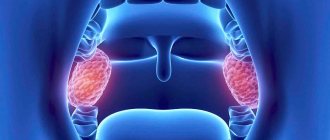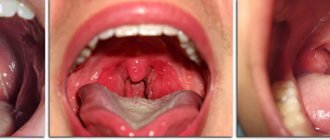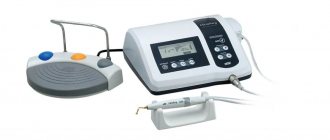Washing methods
This procedure must be carried out carefully, it is better to have it done by a specialist, since with the wrong approach you can aggravate the situation up to the development of sepsis, driving the inflammatory process even deeper or damaging soft tissues.
Washing of the lacunae of the tonsils is carried out in the following ways:
- Using a syringe for intralaryngeal infusions and rinsing of the tonsils.
- Vacuum rinsing of tonsils with the Tonsilor apparatus.
- Deep rinsing using phonophoresis and ultrasound.
Features of each technique
Despite the fact that the use of a syringe can significantly reduce the cost of treating the infected area, the method also has several significant disadvantages. The most important of them is the increased risk of injury, since if the doctor lacks experience, there is a high risk of causing microtrauma with a metal cannula.
If the doctor accidentally made a puncture, then this will result in prolonged healing, which, against the background of a general infection, will generally occur extremely slowly. A scar remains as an eternal reminder, which during the next exacerbation of chronic tonsillitis will become a significant obstacle to the outflow of fluid.
It turns out to be a vicious circle: the patient will get sick again, will come to the appointment again for syringe rinsing due to the inability of the tonsils to independently organize the outflow of fluid. Thus, even initially, for the first time, people who become ill can enroll in the circle of chronic patients.
Another difficulty may be the anatomical structure of the treated area. Due to the tortuosity, reaching all corners of the curved passages will be quite problematic. This increases the percentage probability that the infection will remain stuck for a long time at a practically inaccessible point, constantly making itself known after the condition has partially improved.
Against this background, many victims choose a hardware approach, which involves a higher cost. It also has a number of contraindications, among which pregnancy is especially prominent. When a woman in an interesting situation becomes a victim of a sore throat, she will be sent for treatment using syringe rinses that are safer for the fetus.
At the same time, vacuum intervention is ready to provide a more sustainable effect compared to its outdated counterpart. The method also allows you to almost completely eliminate the risks of a possible accidental puncture of part of the larynx. Regardless of the chosen measure, it is imperative to pay attention to the absolute prohibitions for implementing manipulation. These include:
- acute infectious diseases with elevated body temperature;
- oncological neoplasms of any location;
- tuberculosis.
A relative contraindication would be those people whose gag reflex is pronounced. If you manage to endure it the first time, then, as reviews indicate, in subsequent times the deficiency manifests itself much weaker.
Flushing with a syringe
This method can be offered in any clinic. It is considered painless and lasts about 10 minutes. The patient is seated and asked to open his mouth. A cannula is attached to the syringe. The surface of the pharynx is treated with a solution of local anesthetic. They do this to reduce discomfort during manipulation.
After this, the cannula of the syringe is inserted into the cavities of the tonsils and their contents are sucked out. This can be pus, microorganisms and their metabolic products, food debris, or liquid. After the procedure, the surface is irrigated with anti-inflammatory solutions.
What is the Tonsillor device?
"Tonsillor - 3MM" is used for the conservative and surgical treatment of diseases of the ENT organs through the combined effects of ultrasound, vacuum and ozone/NO-containing medicinal substances on the affected tissues.
Ultrasound, which has healing properties, allows for anti-inflammatory and resorption therapy, pain relief, improves blood microcirculation at the site of exposure, cleans wounds of necrotic tissue and bacterial contamination and creates a drug depot at the site of the lesion. Under the influence of ultrasound, trophism, blood supply to tissues, metabolism improve, and local immunity is stimulated.
Vacuum rinsing of tonsils
Modern otolaryngological offices carry out rinsing of the tonsils with Tonsilor - a special device that carries out cleaning using ultrasound and antiseptic solutions.
It quickly helps to achieve the desired result and has the following effect after use:
- anesthetic;
- antibacterial and antifungal;
- increases local immunity;
- restores normal microflora on the surface of the tonsils.
How is the procedure performed?
The procedure for washing the tonsils is practically painless, but can still cause a gag reflex. To prevent this from happening, you need to apply a solution of lidocaine, which has a freezing effect, to the tonsils in advance. Next, washing should be carried out in several steps:
- A nozzle is placed on the inflamed tonsil and the Tonsillor vacuum mode is started. The pus is pumped out.
- The vacuum effect created by the device allows you to achieve deep cleansing, which does not happen with simple suction with a syringe.
- After pumping out the pus, a special solution is applied to the tonsils for the best result.
- Then, through special tubes, a medicinal solution is pumped into the tonsils using ultrasound. So, the treatment of inflammation occurs from the inside.
Reference. There are contraindications: cardiovascular diseases, diabetes and others.
Contraindications to washing with hardware methods
Despite such a positive effect from hardware methods, in some cases this method cannot be used. These include:
- Retinal detachment.
- Hypertension in stage 3 or 2B.
- 1st and third trimester of pregnancy.
- Acute forms of infectious diseases.
- Oncopathology.
- Atherosclerosis of coronary or cerebral vessels.
- Active tuberculosis.
- Disorders of the autonomic nervous system.
- Pathology of the respiratory and cardiovascular systems in the stage of decompensation.
Causes and symptoms of the disease
Chronic inflammation of the tonsils can be caused by:
- untreated infectious diseases (most often it is a sore throat, so it is necessary to treat a sore throat in a timely and correct manner);
- the presence of other foci of inflammation in the body (for example, chronic sinusitis);
- diseases of the oral cavity (caries, stomatitis, periodontal disease);
- deviated nasal septum;
- heredity;
- reduced immunity;
- stress and nervous tension.
Any chronic disease is characterized by alternating stages of exacerbation and remission. During an exacerbation, the patient complains of pain, soreness, a feeling of a lump in the throat, as well as bad breath (which indicates the presence of purulent plugs in the lacunae of the tonsils). The body temperature rises to 37.5℃. It is very difficult to stay in this state for a long time. But you still need to study, work, lead a normal lifestyle. Only treatment by an otolaryngologist will help alleviate the patient’s condition and get rid of unpleasant symptoms.
Washing tonsils at home
If you have tonsillitis, you can rinse your tonsils at home. Someone close to you can help you with this, or do everything yourself. To begin, prepare a saline or furatsilin solution and thick cotton swabs. Soak the latter well with the resulting liquid and then wash the affected lacunae with light pressure. Repeat the action several times.
Those who know the exact location of the organ can manipulate it using a syringe. The needle is then removed. To use this method, you need to have certain skills.
Frequently asked questions related to the procedure
- How many treatments are needed? To get rid of tonsillitis you need to undergo 5-10 procedures. The specific number is determined by the doctor depending on the extent of the inflammatory process.
- Is pain relief provided? Although irrigation is carried out without a needle, local anesthesia is still used. They do this to reduce discomfort during manipulation.
- How to prepare for the procedure? Preparation consists of refusing to eat at least an hour before the upcoming wash.
- How often should you rinse your tonsils? The need for the procedure depends on the activity of the disease and the rate of accumulation of fluid, food particles, and bacteria in the lacunae. Only the attending physician can determine the frequency of washing. At least once a day.
- How long should I rinse my tonsils? Even if during a single procedure it was possible to completely remove the contents of the lacunae, the manipulation will have to be repeated at least 7-10 more times, it is better to do it every day. This is due to the constant proliferation of pathogenic microflora. And this approach will allow you to achieve stable remission.
- Are there any special features of oral hygiene during the course of treatment? During the course of treatment after each procedure, it is prohibited to eat for the first two hours. It is also worth giving up solid food during this period, since after eating it, a piece may get stuck in the passages.
Thus, washing the tonsils for tonsillitis is an effective treatment method. But if carried out incorrectly, a serious complication can develop, so it is better to contact a specialist.
Why do you need to rinse your tonsils?
The palatine tonsils are an organ of the human immune system. They are located at the very entrance to the pharynx on both sides. Outwardly, they resemble almonds. This similarity gave this organ its name. The tonsils consist of a large number of winding canals - crypts. On the surface of the tonsils there are small depressions - lacunae. It is in them that tonsillitis plugs accumulate, which are removed by washing.
Our tonsils act like a filter. They filter everything that enters the oral cavity from outside. And if infectious flora gets on the surface of the tonsils, they begin to produce lymphocytes - cells of the immune system that begin to fight the “enemy”.
If the body's defenses are not enough to cope with viruses and bacteria, an inflammatory process (chronic tonsillitis) starts in the palatine tonsils. In the gaps, pathogenic microflora is activated, the remains of bacterial activity and dead leukocytes accumulate. This entire “mixture” is compressed and turns into white-yellow plugs on the tonsils, which are noticeable upon examination and emit an unpleasant odor. These plugs do not allow inflammation to subside, so sanitation of the tonsils is an important part of the treatment of chronic tonsillitis.
Often, rinsing is the only way to preserve the tonsils and avoid their removal.
Advantages of treatment at an ENT center
Treatment of ear, nose and throat diseases at the ENT CENTER is a comprehensive and individual approach to each patient. By making a preliminary appointment on the medical center’s website or by phone, you can:
- get face-to-face consultation with a specialist;
- undergo treatment of ENT diseases using progressive techniques;
- receive recommendations for further conservative treatment and prevention of ENT diseases.
Contact the ENT CENTER : here they will help you solve any problem within the competence of ENT doctors as efficiently, safely, quickly and painlessly as possible.
Treatment of tonsillitis
The child should be provided with:
- peace and the opportunity to sleep as much as he wants;
- Drink plenty of fluids to relieve sore throats and prevent dehydration;
- air humidification;
- a sore throat can be relieved by both warm drinks and cold ice cream, especially popsicles;
- for a sore throat, it helps to gargle with a solution of table salt and soda - a teaspoon of salt and a small pinch of soda per 250 ml of warm water;
- Children over 4 years old can be offered lozenges for sore throats. Do not give candy to small children - they may choke;
- do not smoke when your child is sick, avoid strong odors that irritate the throat;
- A sore throat and fever can be relieved by medications containing paracetamol and ibuprofen. Don't give children aspirin; in rare cases, it can cause deadly Reye's syndrome.
Confirmed bacterial tonsillitis (usually streptococcal tonsillitis) is treated with antibiotics. It is dangerous to interrupt or stop the course because it increases the likelihood of infection spreading to the joints, heart, kidneys and other organs. Continue taking antibiotics even if your symptoms are completely gone.









